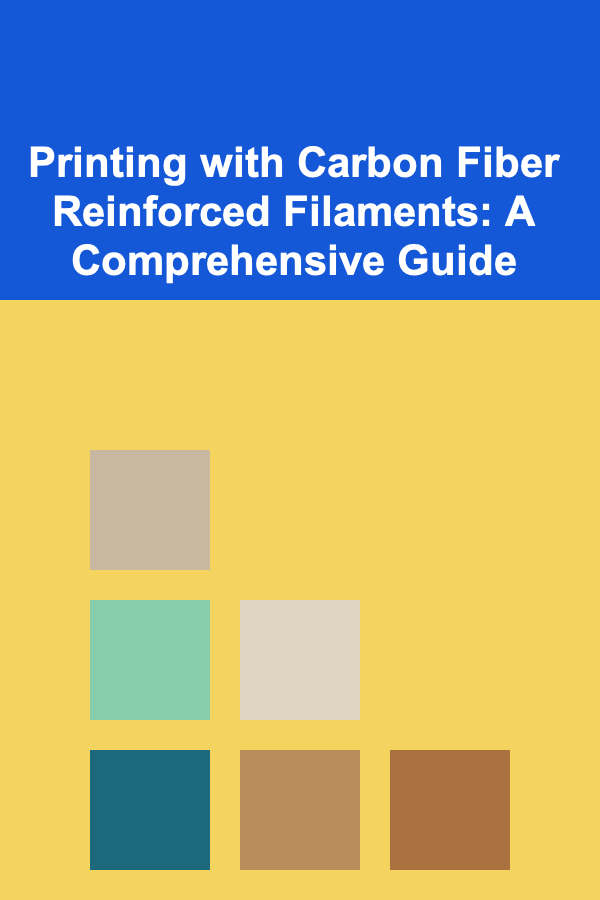
Printing with Carbon Fiber Reinforced Filaments: A Comprehensive Guide
ebook include PDF & Audio bundle (Micro Guide)
$12.99$10.99
Limited Time Offer! Order within the next:

Carbon fiber reinforced filaments have revolutionized the 3D printing landscape, enabling the creation of strong, lightweight, and dimensionally stable parts for a wide range of applications. From aerospace and automotive to robotics and prosthetics, the demand for these materials is rapidly growing. However, printing with carbon fiber filaments presents unique challenges compared to conventional materials like PLA or ABS. This comprehensive guide delves into the intricacies of carbon fiber 3D printing, covering everything from material selection and printer preparation to optimal printing parameters and post-processing techniques.
Understanding Carbon Fiber Reinforced Filaments
Carbon fiber filaments are composite materials consisting of a thermoplastic polymer matrix reinforced with short or continuous carbon fibers. The matrix material is typically a polymer such as Polyamide (PA/Nylon), Polycarbonate (PC), Acrylonitrile Butadiene Styrene (ABS), Polyether Ether Ketone (PEEK), or even PolyLactic Acid (PLA), although the latter is less common due to its lower heat resistance and overall strength. The carbon fibers provide exceptional strength, stiffness, and heat resistance, while the polymer matrix binds the fibers together and allows for the material to be processed using 3D printing techniques.
Types of Carbon Fiber Reinforcement:
- Short Carbon Fiber (SCF): These filaments contain short, chopped carbon fibers dispersed throughout the polymer matrix. SCF filaments offer a good balance of strength, stiffness, and printability. They are generally less abrasive than continuous fiber filaments, making them easier on printer components.
- Continuous Carbon Fiber (CCF): CCF filaments consist of continuous strands of carbon fiber embedded in the polymer matrix. These filaments offer significantly higher strength and stiffness compared to SCF filaments, but require specialized printing techniques and hardware. They are typically used in processes like Continuous Fiber Fabrication (CFF) where the continuous fiber is laid down in a specific pattern within the printed part. This is more complex and expensive, but results in parts with near-isotropic properties.
Benefits of Carbon Fiber Reinforced Filaments:
- High Strength-to-Weight Ratio: Carbon fiber filaments offer exceptional strength and stiffness while remaining lightweight, making them ideal for applications where weight reduction is crucial.
- High Stiffness: The addition of carbon fibers significantly increases the stiffness of the material, resulting in parts that are resistant to bending and deformation under load.
- Dimensional Stability: Carbon fiber reinforced filaments exhibit low thermal expansion, resulting in parts with excellent dimensional stability and reduced warping.
- Heat Resistance: Depending on the matrix material, carbon fiber filaments can offer improved heat resistance compared to conventional thermoplastics. PEEK-CF, for example, can withstand very high temperatures.
- Chemical Resistance: Certain carbon fiber filaments offer good resistance to chemicals and solvents, making them suitable for use in harsh environments.
Drawbacks of Carbon Fiber Reinforced Filaments:
- Abrasiveness: Carbon fibers are highly abrasive and can quickly wear down standard brass nozzles. Using hardened steel or ruby nozzles is essential.
- Cost: Carbon fiber filaments are generally more expensive than conventional filaments. The higher cost is due to the added expense of the carbon fiber material and the more complex manufacturing process.
- Printability Challenges: Carbon fiber filaments can be more challenging to print with than PLA or ABS, requiring careful optimization of printing parameters.
- Potential for Warping: While generally better than some plastics, warping can still occur, especially with larger prints and filaments with a high percentage of carbon fiber.
- Interlayer Adhesion: Achieving good interlayer adhesion can sometimes be challenging with carbon fiber filaments, requiring precise temperature control and proper cooling strategies.
- Brittleness: While strong and stiff, parts printed with carbon fiber can sometimes be brittle, especially if the printing parameters are not optimized.
Preparing Your 3D Printer for Carbon Fiber Filaments
Before attempting to print with carbon fiber filaments, it's crucial to prepare your 3D printer to handle the unique properties of these materials. This involves upgrading certain components and adjusting printer settings to ensure successful prints.
Nozzle Selection:
As mentioned earlier, carbon fibers are highly abrasive and will quickly wear down standard brass nozzles. Using a brass nozzle with carbon fiber filament is highly discouraged, as it will lead to rapid nozzle degradation and inconsistent print quality. Here are the recommended nozzle materials for carbon fiber printing:
- Hardened Steel: Hardened steel nozzles offer good wear resistance at a relatively affordable price. They are a popular choice for printing with short carbon fiber filaments.
- Tool Steel: Offering superior wear resistance compared to hardened steel, tool steel nozzles are an excellent option for printing with both short and continuous carbon fiber filaments, especially for high-volume production.
- Ruby Nozzles: Ruby nozzles feature a synthetic ruby tip that is exceptionally resistant to abrasion. They are a premium option that provides excellent print quality and long lifespan.
- Tungsten Carbide: Tungsten carbide offers excellent wear resistance but can be more expensive and less common.
Consider the following factors when choosing a nozzle:
- Material Abrasiveness: Higher carbon fiber content requires a more wear-resistant nozzle.
- Printing Volume: For frequent printing, a more durable nozzle like ruby or tool steel is recommended.
- Budget: Hardened steel nozzles are the most affordable option, while ruby nozzles are the most expensive.
Extruder Upgrades:
A reliable extruder is essential for feeding the filament consistently and accurately. Consider upgrading your extruder with the following features:
- Direct Drive Extruder: Direct drive extruders mount the motor directly above the hot end, reducing the distance the filament needs to travel and improving responsiveness. This is particularly beneficial for flexible or brittle filaments like some carbon fiber blends.
- Dual Gear Extruder: Dual gear extruders use two gears to grip the filament, providing a more secure and consistent feed. This helps prevent slipping and under-extrusion, which can be common with carbon fiber filaments. Bondtech extruders are a popular example.
- All-Metal Hot End: An all-metal hot end allows for higher printing temperatures, which may be necessary for certain carbon fiber filaments with high-temperature polymer matrices like PEEK-CF.
Build Plate Adhesion:
Proper build plate adhesion is crucial for preventing warping and ensuring that the print adheres securely to the build surface. Consider the following strategies:
- Heated Bed: A heated bed is essential for printing with most carbon fiber filaments. The optimal bed temperature will vary depending on the matrix material, but generally ranges from 60°C to 120°C.
- Build Surface Materials:
- PEI (Polyetherimide): PEI sheets offer excellent adhesion for a wide range of filaments, including carbon fiber reinforced materials. They are relatively durable and easy to clean.
- Glass: Glass build plates can provide a smooth and even surface for printing. Applying a layer of adhesive such as glue stick or hairspray is often necessary to improve adhesion.
- Garolite/FR4: Garolite offers excellent adhesion and is commonly used with high-temperature materials.
- Adhesion Aids:
- Glue Stick: A thin layer of glue stick can significantly improve adhesion and prevent warping.
- Hairspray: Hairspray can provide a similar level of adhesion as glue stick.
- Brims and Rafts: Brims and rafts increase the surface area of the first layer, improving adhesion and stability. A brim is a single-layer outline around the base of the print, while a raft is a thicker, multi-layer structure.
Enclosure (Optional but Recommended):
An enclosure helps maintain a consistent temperature around the print, reducing warping and improving interlayer adhesion, especially when printing with materials prone to shrinkage like Nylon-CF. An enclosure is especially beneficial when printing with higher temperature materials like PC-CF or PEEK-CF.
Optimizing Printing Parameters for Carbon Fiber Filaments
Once your printer is properly prepared, the next step is to optimize the printing parameters for carbon fiber filaments. These parameters will vary depending on the specific filament and your printer, but here are some general guidelines:
Temperature Settings:
- Nozzle Temperature: The optimal nozzle temperature will depend on the matrix material of the carbon fiber filament. Refer to the manufacturer's recommendations for specific temperature ranges. Generally, carbon fiber filaments require higher nozzle temperatures than PLA, typically ranging from 220°C to 300°C or higher for high-temperature materials like PEEK-CF.
- Bed Temperature: As with nozzle temperature, the optimal bed temperature depends on the matrix material. Generally, bed temperatures range from 60°C to 120°C. Using an enclosure can help maintain a more consistent bed temperature.
- Enclosure Temperature (If Applicable): For filaments prone to warping, maintaining a consistent enclosure temperature (e.g., 40-50°C) can significantly improve print quality. High-temperature materials like PEEK-CF often require a heated chamber.
Print Speed:
Carbon fiber filaments often require slower print speeds than conventional filaments. Printing too fast can lead to under-extrusion, poor layer adhesion, and increased risk of warping. A general starting point is to reduce the print speed by 20-30% compared to what you would typically use for PLA. Experiment with different speeds to find the optimal balance between print quality and print time.
- First Layer Speed: Slowing down the first layer speed (e.g., 20-30 mm/s) can improve adhesion and prevent warping.
- Outer Wall Speed: Reducing the outer wall speed can improve surface finish and dimensional accuracy.
- Infill Speed: Infill speed can generally be slightly faster than outer wall speed.
Layer Height:
The optimal layer height for carbon fiber filaments is typically between 0.1mm and 0.2mm. Lower layer heights can improve surface finish and detail, but may also increase print time. Higher layer heights can speed up printing but may compromise print quality. It is often recommended to use a layer height that is a multiple of your printer's Z-axis step resolution for optimal results.
Retraction Settings:
Proper retraction settings are crucial for preventing stringing and oozing. The optimal retraction distance and speed will depend on your extruder and filament. Experiment with different settings to find the values that minimize stringing without causing under-extrusion. A good starting point is to use retraction distances similar to those used for PLA, but you might need to adjust them slightly. Direct drive extruders generally require shorter retraction distances than Bowden extruders.
Fan Settings:
Excessive cooling can lead to warping and poor layer adhesion with some carbon fiber filaments. It is generally recommended to reduce or even disable the cooling fan, especially for the first few layers. However, some cooling may be necessary for bridging and overhangs. Experiment with different fan settings to find the optimal balance between cooling and adhesion.
Infill Density and Pattern:
The infill density and pattern will affect the strength and weight of the printed part. Higher infill densities will result in stronger and heavier parts, while lower infill densities will result in lighter and weaker parts. Common infill patterns include rectilinear, honeycomb, and gyroid. For carbon fiber filaments, a rectilinear infill pattern is often preferred, as it provides good strength and stiffness in both the X and Y directions. Consider the intended application of the part when choosing the infill density and pattern.
Flow Rate:
Ensuring accurate extrusion is crucial for print quality. Calibrating the flow rate (also known as extrusion multiplier) can help compensate for variations in filament diameter and extruder performance. Print a single-wall test cube and measure the wall thickness to determine the appropriate flow rate adjustment.
Support Structures:
Generating effective support structures is vital for printing complex geometries with overhangs. When using carbon fiber filaments, it's generally recommended to use support structures that are easy to remove, as carbon fiber filaments can be difficult to cut or sand. Consider using soluble support materials like PVA (Polyvinyl Alcohol) for complex geometries. The support interface settings (e.g., support density, support interface layers) can be adjusted to balance support strength and ease of removal.
Post-Processing Carbon Fiber 3D Prints
After printing, post-processing may be necessary to improve the appearance, functionality, or dimensional accuracy of the printed part.
Support Removal:
Carefully remove support structures using appropriate tools such as pliers, cutters, or a heat gun. Avoid damaging the part during support removal. As mentioned, soluble support materials greatly simplify this process.
Sanding and Finishing:
Carbon fiber filaments can be sanded and finished to improve surface quality. Start with coarse sandpaper and gradually move to finer grits. Wear a respirator mask to avoid inhaling carbon fiber dust. Consider applying a clear coat or epoxy resin to protect the surface and enhance the appearance.
Machining:
Carbon fiber prints can be machined using conventional machining techniques, but special care must be taken to avoid damaging the part or creating excessive dust. Use sharp tools and low cutting speeds. Wear appropriate safety equipment, including a respirator mask and eye protection.
Bonding and Assembly:
Carbon fiber parts can be bonded together using adhesives such as epoxy resin or cyanoacrylate (super glue). Prepare the surfaces properly by sanding and cleaning them before applying the adhesive. Clamping or fixturing may be necessary to ensure a strong and accurate bond.
Safety Precautions
Printing with carbon fiber filaments requires certain safety precautions to protect yourself and your environment:
- Ventilation: Ensure adequate ventilation in the printing area to remove fumes and particles. Consider using a HEPA filter to capture airborne particles.
- Respirator Mask: Wear a respirator mask when sanding or machining carbon fiber parts to avoid inhaling carbon fiber dust.
- Eye Protection: Wear safety glasses or goggles to protect your eyes from flying debris.
- Skin Protection: Wear gloves to protect your skin from irritation.
- Proper Disposal: Dispose of waste materials properly according to local regulations.
Troubleshooting Common Issues
Even with careful preparation and optimized printing parameters, you may encounter some common issues when printing with carbon fiber filaments:
- Warping: Ensure proper bed adhesion, use a heated bed and enclosure, and reduce cooling fan speed.
- Under-Extrusion: Increase nozzle temperature, reduce print speed, and check for extruder issues (e.g., clogged nozzle, slipping extruder gears).
- Stringing: Optimize retraction settings (distance and speed) and reduce nozzle temperature.
- Poor Layer Adhesion: Increase nozzle temperature, reduce print speed, and ensure proper bed adhesion. Use an enclosure to maintain a consistent ambient temperature.
- Clogging: Use a clean filament, ensure proper nozzle temperature, and consider using a filament filter. Regular cleaning of the nozzle is also important.
- Abrasive Wear: Replace brass nozzles with hardened steel, ruby, or tool steel nozzles.
Conclusion
Printing with carbon fiber reinforced filaments offers exciting possibilities for creating strong, lightweight, and dimensionally stable parts. By understanding the properties of these materials, properly preparing your 3D printer, optimizing printing parameters, and following safety precautions, you can successfully print with carbon fiber filaments and unlock their full potential. Remember that experimentation is key -- each printer and filament combination will require fine-tuning to achieve optimal results. As technology advances, we can expect to see even more innovative carbon fiber filaments and printing techniques emerge, further expanding the applications of this versatile material.

10 Smart Tips for Saving on College Expenses
Read More
How to Make a Checklist for Posting Consistently on Social Media
Read More
How to Store and Organize Your Books Without Cluttering Your Home
Read More
What Should You Know About Organizing Your Bathroom Products?
Read More
How To Cultivate a Positive Team Culture
Read More
Understanding the Psychological Impact of Virtual Reality
Read MoreOther Products

10 Smart Tips for Saving on College Expenses
Read More
How to Make a Checklist for Posting Consistently on Social Media
Read More
How to Store and Organize Your Books Without Cluttering Your Home
Read More
What Should You Know About Organizing Your Bathroom Products?
Read More
How To Cultivate a Positive Team Culture
Read More